
It’s been a while since we’ve put out a Needles in the Stacks issue, so it’s time. The library has a lot of “how-to” sewing books. Many women (and a few men) have converted their passion for sewing into publishing businesses, video performances, and workshops. One well known such teacher was Nancy Zieman. Zieman died on November 14, 2017 from cancer.

Zieman began a mail-order sewing supply business, Nancy’s Notions in 1979, after working for Minnesota Fabrics (a large midwestern chain of fabric stores.) Because of her business and experience, a Milwaukee fabric store asking her to host a sewing program in 1982. This didn’t survive beyond a dozen or so shows, but it inspired Zieman to launch her own show, on Wisconsin Public Television, beginning fall of 1982. The show became popular and was picked up by public television stations across the U.S. and Canada.
The library has 13 of Zieman’s books, although she published more than 80 over her career. In addition, she made nearly as many videos and DVDs and her television show ran for 35 years. To honor her, I thought it would be a great opportunity to take a look through these titles. Because there are so many, this post will be in 2 parts. There is a link to the second half at the end of this one.
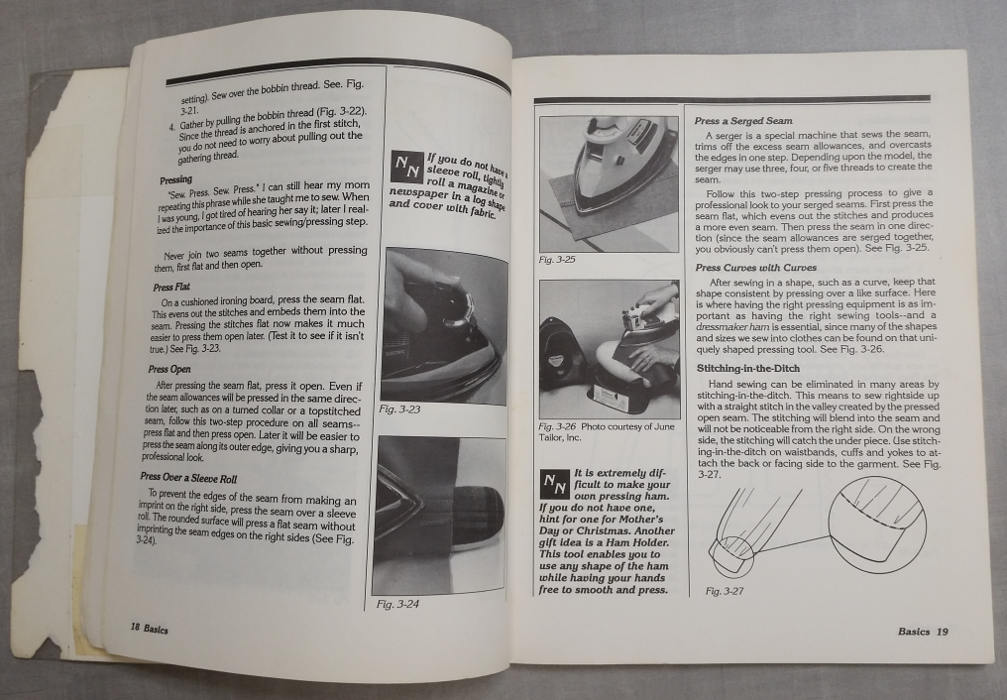
When we compare books from different decades, it’s easy to see the way the publishing industry has changed. When Zieman began her publishing career (early 1980s), color images and technical drawings were expensive to print. As a result, consumers didn’t expect many images. How-to books with big blocks of text were common. In addition, Zieman’s books were published inexpensively by small, local publishers. As her popularity grew, larger publishing houses published her work and invested more in the production of the books themselves. This shows clearly in the range of books FIT has.
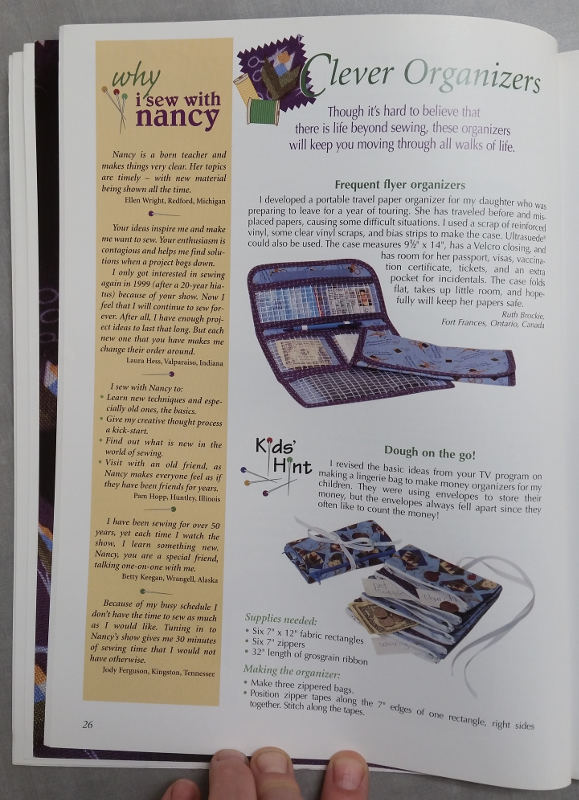
In addition, publishing methods for technical drawings changed a lot between 1970 and 2000. The birth of Apple computers and the availability of computer-aided publishing software like Adobe Illustrator allowed sharper, repeating images with differentiated textures and colors. Typeface styles have also changed a lot in that time. And American culture has become much more demanding photographs showing process in how-to manuals. Many recent manuals even include video on CD-roms augmenting the text.
Because desktop publishing was new then, a good number of the manuals we have from the 1980s are only a notch better than printed at home.
List of Zieman’s books FIT has, in StyleCat
Slacks “Pivot-Slide” Fitting Book, 1982
This is a self-published paperback on how to fit and sew professionally styled pants. It’s very basic, with line drawings and black and white stitching illustrations that resemble commercial pattern instructions. It includes a sizing chart for women, along with a basic pants pattern from which to work. The methods taught are simple pivot and slide, included because they are less time consuming that slash and spread.

The Busy Woman’s Sewing Book, 1988
This book is a small format paperback. Illustrated with black and white line drawings, it was probably produced inexpensively and published by Nancy’s Notions company along with another small California press. It and the next book were co-authored by Robbie Fanning, a columnist for “Needlecraft for Today”. The book is aimed at both homemakers and working women balancing child-rearing and home maintenance with their desire to sew for fun and dress well on a budget. Like most of her books, it assumes basic understanding of machine sewing techniques, but teaches ways to improve skills.
Zieman’s goal, stated on the back blurb, was to help the reader “plan a season’s wardrobe by perfecting one semi-lined jacket, one blouse and dress, and one skirt and slacks pattern. With this plan you can sew faster than you could shop.” She helps readers reach this ambitious goal by teaching them to plan their projects and organize their tools. Basic project tracking and measurement chart templates are included in the back.
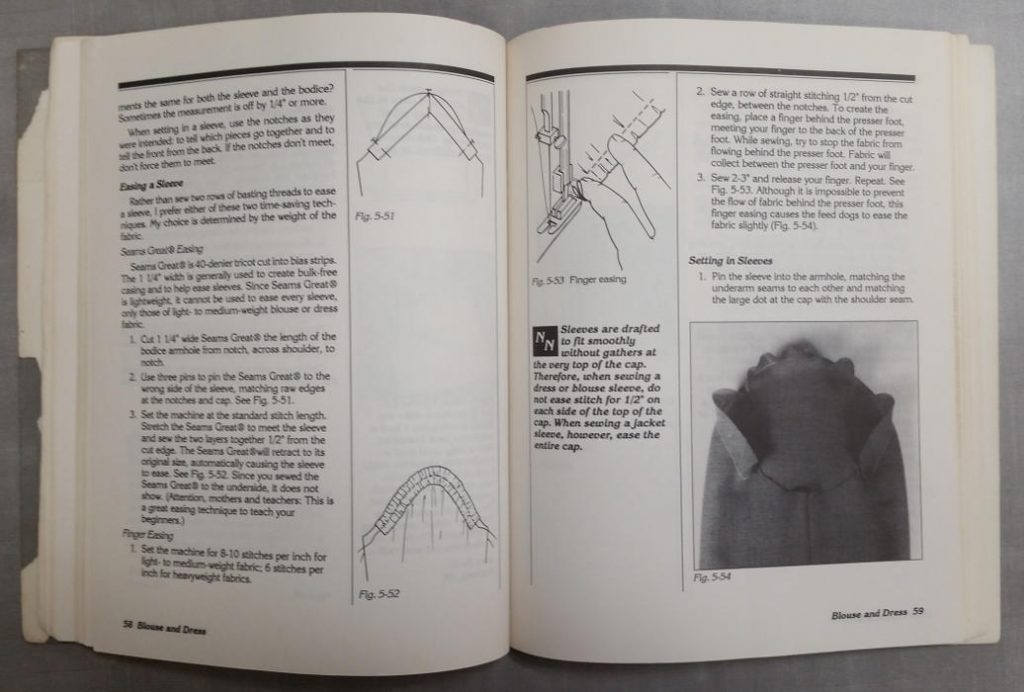
A busy woman herself, Zieman stresses the importance of *starting*, no matter how little time the reader has to actually work. She points out that things worked on in tiny time increments still eventually get finished. Then she adds tips for sewing faster, steps to eliminate, and steps to combine. In addition she adds industry shortcuts like “stitch in the ditch” and use of fusible interfacings to cut out handwork time.
The book is organized by the basic garments she listed on the back, with shortcuts and tips included. In addition, she includes many tips and shortcuts that her viewers and readers wrote in, making the whole book feel like a homey group endeavor. Some of the pieces in the book are growing obsolete, like half slips and women’s jackets. But in the Midwestern US in 1988, these were still wardrobe basics.
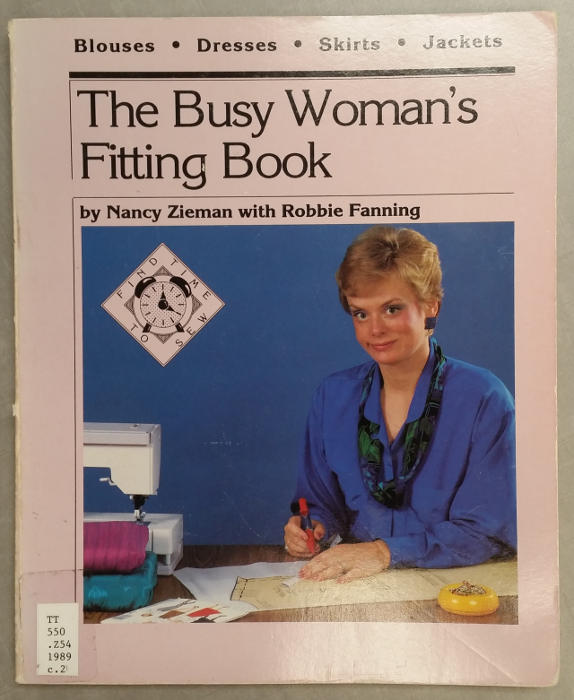
The Busy Woman’s Fitting Book, 1989
This title has the same publisher, co-author, and format as the last one, but this time the focus is on fitting problems and altering commercial patterns to accommodate them. Getting correct fit continues to be difficult for many inexperienced sewers. The concepts are so important that Zieman expanded upon the topic several times. Our library has versions called Fitting Finesse, published in 1994, and Pattern Fitting with Confidence in 2009 (see pt. 2 of this post), but Zieman published many other variations in both book and video formats. In each case, tech advances in publishing allowed the new edition to present the concepts with sharper, more detailed illustration and an updated layout.
Here Zieman focuses on making alterations to commercial patterns to solve fitting problems. The only basic patternmaking concept introduced is that of pivot-to-open/close or move darts and seams. It’s interesting that, even with her years of sewing experience and teaching, Zieman never taught her audience how to make their own patterns.

Despite its old-style illustrations and (few) black and white images, this book holds up pretty well. The pattern pieces shown are basic enough that the lessons are still useful. A newer manual might illustrate the lessons more attractively, but the information is organized clearly and contains frequent tips and explanations that would still be useful to any sewer.
10-20-30 Minutes to Sew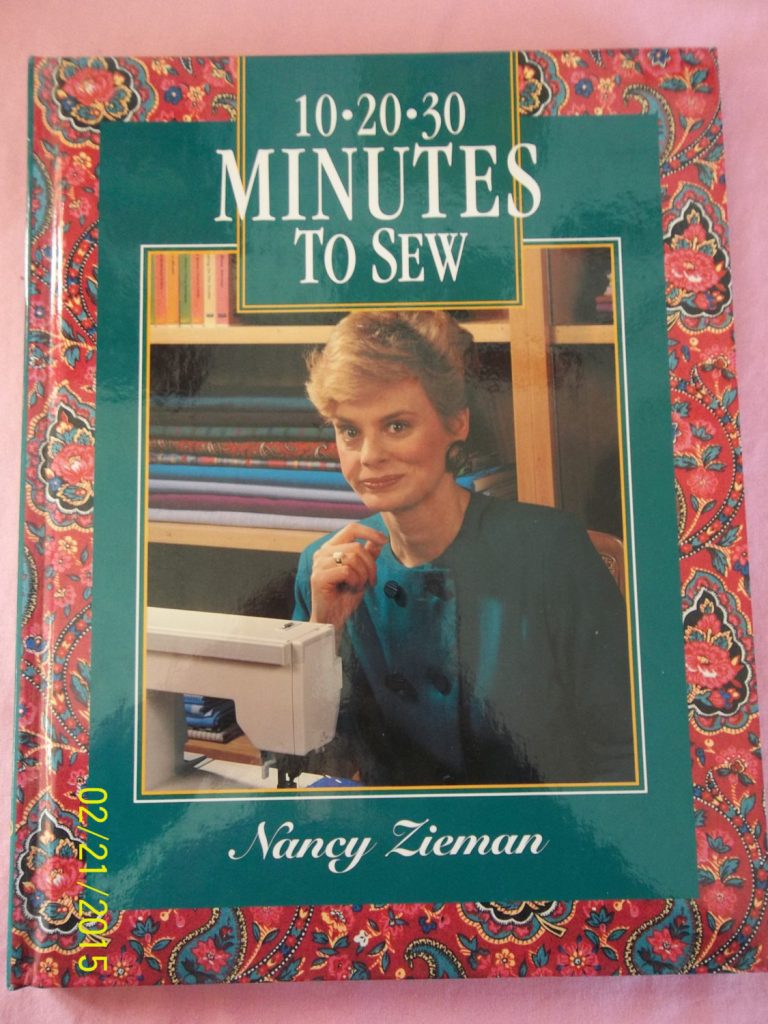 , 1992
, 1992
This entire book is set up to move sewing projects along in tiny increments of one’s day. Zieman lists short tasks that make more time for the next longer window of sewing opportunity. A lot of them are smallish, like iron the pattern pieces and put them over a hanger so they are ready when next you are. These strategies are a clever way to help a busy person get more sewing done, even when it doesn’t feel like she has time to.
Or test the fusible interfacing you’re planning on using so you know how it behaves before applying it in the garment. Or use a spare few minutes to set up your sewing machine. Other time hacks are more complicated, like acquiring a serger.
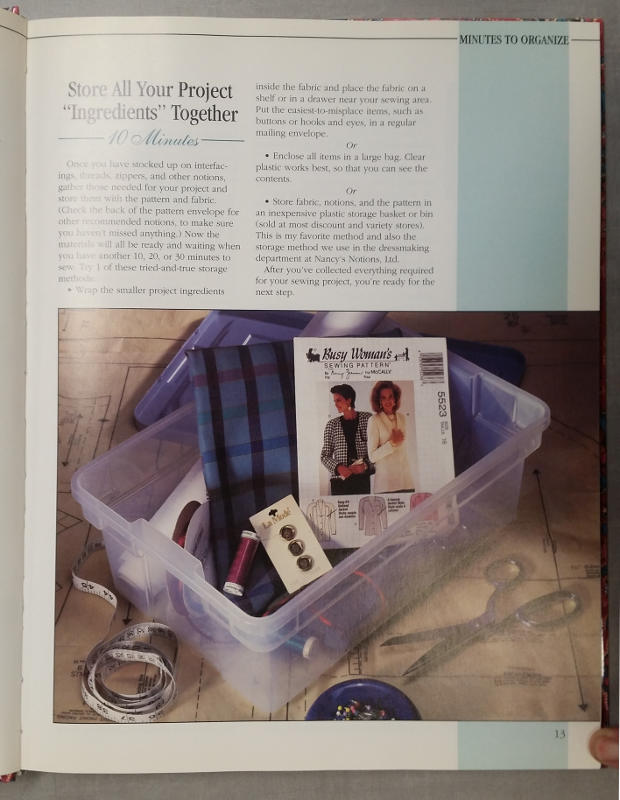
Many of these suggestions could easily qualify as helpful hints, but the book demonstrates the crisp organization that allowed Zieman herself to build a sewing empire and produce so prolifically. Being a busy woman myself, I welcomed the premise that I can keep my hand in my sewing projects even with tiny bits of time to spare from work, friends, housekeeping and graduate school. For that matter, this approach helped me get more writing done as well.

Although Zieman’s techniques are more home-sewing techniques than industrial, she applies streamlining cuts, stitches, and finishes in an industrial sort of way, that is, subtracting steps at every level and minimizing or removing handstitching on most garments. In addition, Zieman’s approach takes on every sort of fabric item in a household. She offers a detailed tutorial on how knits differ from wovens. She includes notes on elastic and creating underwear and sweatshirts. Then in the back section she gives examples of different seam finishes, different sewing machine feet, their uses, and a glossary of terms. This book assumes a basic level of machine sewing skills.
This book is really dated (athletic wear is called “active wear”), but the techniques in it are helpful. I personally have a fear of knits, so I appreciate the whole section explaining different types of knits and elastics. Zieman taught fearlessness and that no fabric was too difficult when approached knowledgeably.
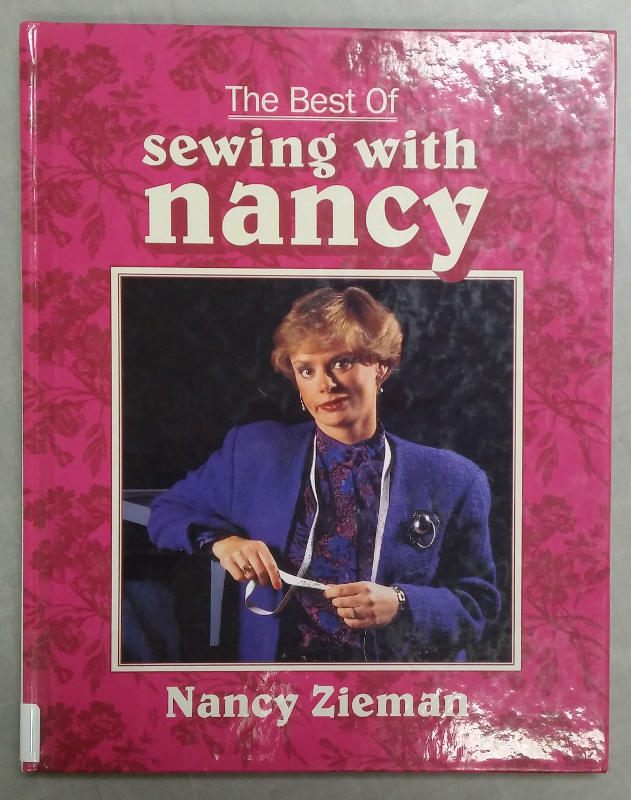
The Best of Sewing with Nancy, 1993
This book is a roundup of techniques celebrating the 10th anniversary of the PBS show, “Sewing with Nancy”. Like 10-20-30 Minutes, Fitting Finesse, and Sewing Express, this hardback, large format book is printed on glossy paper, with full color photographs. They were published by Oxmoor House, the company that launched Southern Living. They expanded to produce how-to books, and Zieman was a regular on their lists.
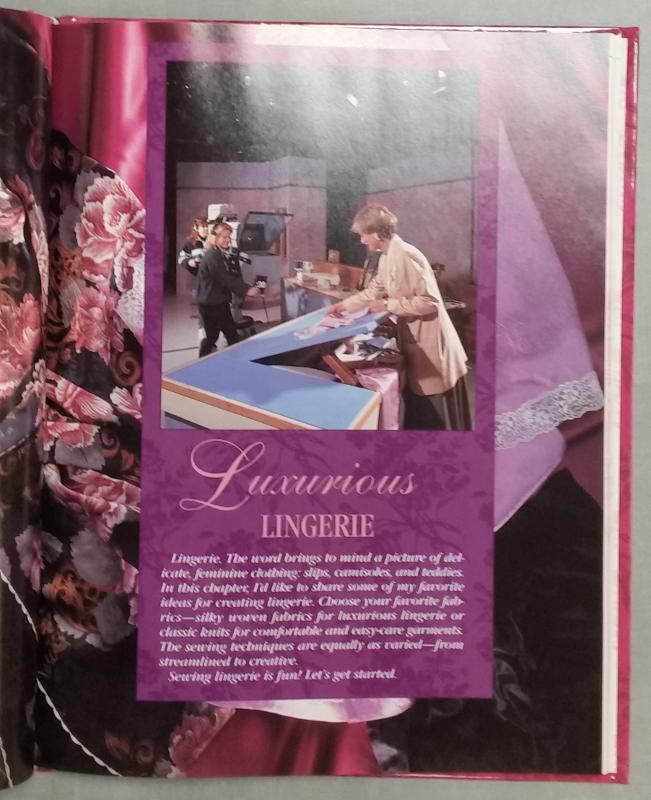
This book continues themes introduced in 10-20-30 (above), with careful explanations of tools and notions, and sewing basics in the back. This time, however, the book covers making lingerie and christening gowns, introduces quilting’s piecing techniques to embellish outerwear (like sweatshirts), and includes an extensive section on making garment and jewelry carriers.
In addition, it picks up another favorite topic of Zieman’s, the tailored jacket, created with speedy fusible interfaced and machine techniques. The last section covers another theme Zieman went on to highlight further, surface embellishments created with machine embroidery and applique.
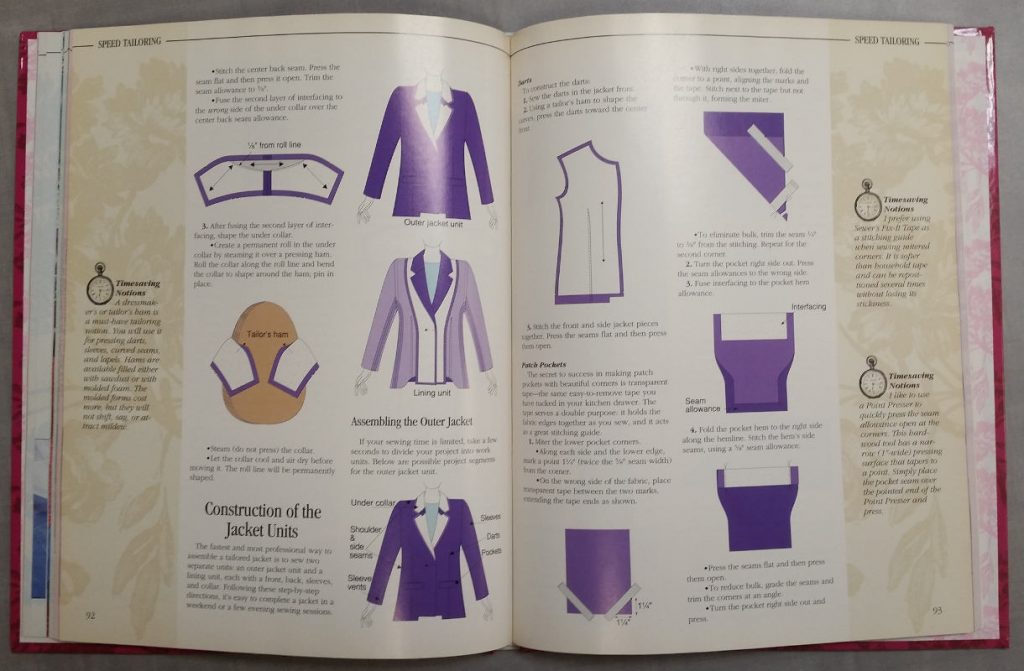
Nancy’s frequent notes give parenthetical pointers once the main instructions are laid out. Like most sewing manuals of the past, many of the projects don’t travel past their fashion expiration date well. In this book, the sweatshirts with carefully pieced insets and the machine appliqued button plackets are wince-worthy reminders that fashions of the 1980s remained current longer in the Midwest.
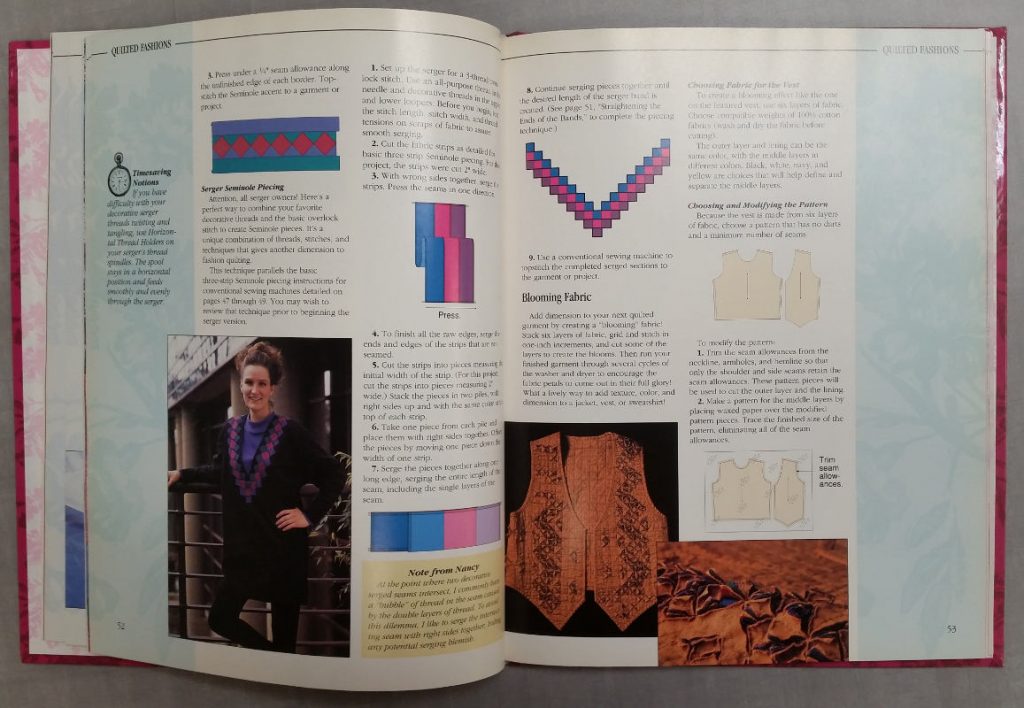
Zieman’s personal style embraced the broad shoulderpads of her youth. But the techniques to create romantic lace insets and bang out tailored jackets in minimal time are excellent, and the small tips and reminders are solid. Zieman’s clear project descriptions demonstrate why she remained successful in this field until her death.

Fitting Finesse, 1994
This is the third book FIT has of Zieman’s which is the large format hardback published by Oxmoor House. This book, an expansion of her early “Busy Woman’s Fitting Book”, holds up particularly well because people’s bodies haven’t changed all that much, even if fashion and available materials have.
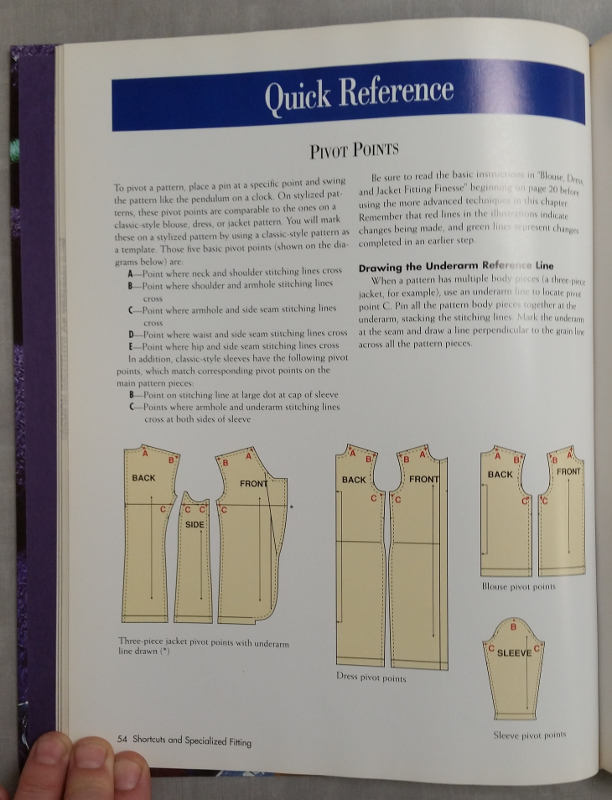
The multi-color diagrams of pattern manipulation help make this book a lot more accessible than it’s predecessor. Red and green arrows demonstrate the directions of the pivot moves, and the entire format is larger and easier to see. The line drawn figures help depict the fitting problems, but the line drawn wrinkles aren’t as clear indicators as photographs will be in more recent manuals.

Expanded from the earlier version described above, this title covers a wonderful range of possible fitting problems. The pieces Zieman uses are close enough to standard slopers that this book will remain useful for a long time.
With the huge publication list, it’s sad that none of these fitting manuals address pattern adjustments for men’s fit. Zieman’s interests extended to many useful tools and later into quilting techniques, but we must look to other sewing teachers for help sewing for men.
That’s the first half of our books by Nancy Zieman. I will review more of these in a few weeks. In the meantime, here’s an earlier Needles in the Stacks post to tide you over!
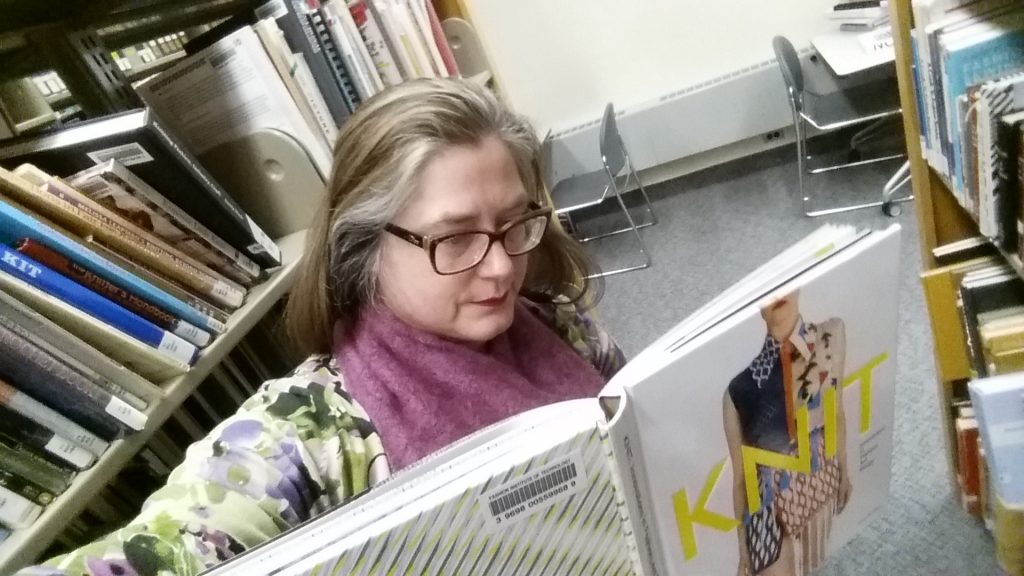
Beth
http://www.nancyzieman.com/blog/
http://www.nancyzieman.com/blog/quilting-2/a-personal-note-from-nancy/
https://wpt.org/SewingWithNancy/Video
Comments
2 responses to “Needles in the Stacks: Sewing with Nancy Zieman, pt.1”
[…] few weeks ago, I posted the first half of our Needles in the Stacks series reviewing the books of the late Nancy Zieman. The FIT library has How-To sewing books published by more than a dozen famous sewing […]
I have enjoyed Nancy zieman productions for years and have used her products. She has been and will always be a great inspiration. Thank you Nancy Zieman